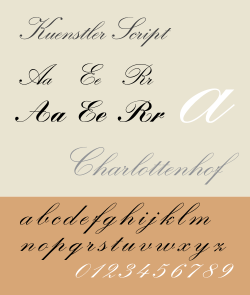Calligraphic
| Typeface name | Example 1 | Example 2 | Example 3 |
|---|---|---|---|
| American Scribe | |  |  |
| AMS Euler Designer: Hermann Zapf, Donald Knuth | |  | |
| Apple Chancery Designer: Kris Holmes |  |  |  |
| Brush Script Designer: Robert E. Smith | |  |  |
| Cézanne Designer: Michael Want, Richard Kegler | |  | |
| Coronet Designer: R. Hunter Middleton |  |  |  |
| Declaration Script | | ||
| Declare |  | ||
| Edwardian Script Designer: Ed Benguiat | |  |  |
| FIG Script Designer: Eric Olson | |  |  |
| French Script | |  | |
| Gravura Designer: Phill Grimshaw |  |  | |
| Kuenstler Script Designer: Hans Bohn | |  |  |
| Lucida Calligraphy Designer: Charles Bigelow, Kris Holmes | |  |  |
| Monotype Corsiva Designer: Tricia Saunders | |  |  |
| Snell Roundhand Designer: Matthew Carter |  |  |  |
| Zapf Chancery Designer: Hermann Zapf | |  | |
| Zapfino Designer: Hermann Zapf |  |  |  |





































